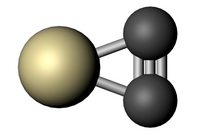Silacyclopropynylidene, v3 = 3 (Extrapolation)
 | |
|---|---|
| Species tag | 052537 |
| Version | 1* |
| Date of Entry | Oct. 2015 |
| Contributor | H. S. P. Müller |
|
SiC2 is a cyclic molecule with a fairly low barrier
to linearity which is probably responsible for the large
centrifugal distortion effects, especially in excited
vibrational states involving excitation of v3.
The v3 mode can be considered as asymmetric
SiCC bending motion or as the C2 internal rotation
motion. Ka odd are permitted only
in contrast to Ka even for the ground
vibrational state. This is because of the different vibrational
symmetry. | |
| Lines Listed | 126 |
| Frequency / GHz | < 400 |
| Max. J | 19 |
| log STR0 | -6.5 |
| log STR1 | -4.5 |
| Isotope Corr. | -0.0445 |
| Egy / (cm–1) | 487.2 |
| µa / D | 2.393 |
| µb / D | |
| µc / D | |
| A | 57460. |
| B | 12706.8 |
| C | 9729.3 |
| Q(300.0) | 5208.0814 |
| Q(225.0) | 3375.3615 |
| Q(150.0) | 1833.7985 |
| Q(75.00) | 647.6255 |
| Q(37.50) | 229.2305 |
| Q(18.75) | 81.3646 |
| Q(9.375) | 29.0251 |
| Q(5.000) | 11.6560 |
| Q(2.725) | 5.4248 |
| detected in ISM/CSM | no |